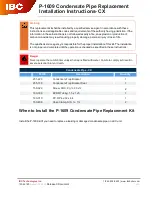
27
initial start up, when air is being purged from the
piping, to require two to three tries before successful
ignition.
•
With the boiler running, check for flue gas leaks along
the inner cabinet joints and around the flue outlet.
Some minor leakage is acceptable.
•
Repair any major leaks prior to proceeding to the next
step.
•
At the factory adjustments were made to achieve
proper input and acceptable burner performance at full
input and at minimum input.
•
Depending on field conditions, the CO
2
trim valve may
require some minor adjustment at full input. Refer to
Figure #3. Always set the appliance for a CO
2
level in
the range of 7.5% to 8.0%. Adjustment at minimum
input can be done at the low fire adjustment screw by
first removing the brass cap. Turning adjustment screw
clockwise will increase CO
2
.
8.3 FIRE
TESTING
•
This boiler is designed for low fire soft start. At the start
of trial for ignition the fan will decelerate to minimum
fire and will light off at low fire before ramping up
towards full input depending on the 4 – 20 mA signal
from the controller.
•
Shut power off to the heater and open the firing valve.
Switch power back on and allow the burner to fire.
Ignition should be smooth with typical differential air
pressures as shown in Table 8: Normally the
differential gas pressure will be identical to the
differential air pressure. Actual differential pressure
may vary from above numbers due to the field
conditions and sample variations. Always make
adjustments to meet the recommended CO
2
levels.
Adjust high fire first followed by adjustment to the low
fire settings.
•
Check combustion. For natural gas the CO
2
reading at
full fire should not exceed 8%. At low fire, CO
2
will be
between 7% and 7.5%. For propane, reading will be
approximately 1.5% higher.
•
Allow the water temperature to rise so that the heater
cycles on the operator.
•
Check the temperature rise across the heat exchanger.
This will be item
Δ
T on the SmartFlame control. For
hydronic applications and for domestic hot water, a rise
exceeding 35ºF is not normally recommended. After
confirming temperature rise, set the control to the
“OUT” temperature display using the item key.
•
Allow the unit to cycle on the limit. This can be done by
gradually restricting outlet water flow. The auto reset
limits are set at 200ºF for domestic hot water and
230ºF for hydronic heating. In addition the heaters are
equipped with a manual reset high limit set at 210ºF for
domestic hot water and 250ºF for hydronic heating.
After confirming limit operation return the control to the
“IN” temperature display.
•
Remove fan inlet filter. During trial for ignition, block
75% of the fan inlet opening. The air flow light should
de-energize. If it does not, slowly turn the adjustment
screw clockwise until the light de-energizes.
•
Check the differential pressure switch. Remove the
restriction from the fan inlet and reset the power on the
control panel. A properly set air switch will cause the
air flow light to energize at a fan speed between 15Hz
and 20Hz on the VDF.
•
Check the ignition retries circuit.
•
Shut the main gas off to the unit and allow it to try for
ignition. Trial for ignition should commence within 30
seconds.
8.4 COMISSIONING
APPLIANCE
•
Remove manometers and replace inlet gas pressure
test plug.
•
Fill out start up report for each heater. Be sure to
record all settings and readings. Retain a copy of
report for future reference.
•
Start up is now complete and heater may be placed
into service.
Содержание DFH500
Страница 31: ...28 PART 9 TROUBLE SHOOTING ...
Страница 32: ...29 ...
Страница 39: ...36 PART 12 EXPLODED VIEW ...
Страница 40: ...37 ...
Страница 41: ...38 ...
Страница 46: ...43 PART 13 ELECTRICAL DIAGRAMS ...
Страница 47: ...44 ...
Страница 48: ...45 ...
Страница 49: ...46 ...
Страница 50: ...47 ...
Страница 51: ...48 ...
















































